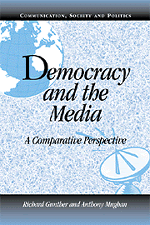Book contents
- Frontmatter
- Contents
- List of Contributors
- Acknowledgments
- 1 The Media in Democratic and Nondemocratic Regimes: A Multilevel Perspective
- 2 The Media and Politics in Spain: From Dictatorship to Democracy
- 3 Institutional Incapacity, the Attentive Public, and Media Pluralism in Russia
- 4 Democratic Transformation and the Mass Media in Hungary: From Stalinism to Democratic Consolidation
- 5 The Modernization of Communications: The Media in the Transition to Democracy in Chile
- 6 Media Influence in the Italian Transition from a Consensual to a Majoritarian Democracy
- 7 The United States: News in a Free-Market Society
- 8 Japan: News and Politics in a Media-Saturated Democracy
- 9 The Netherlands: Media and Politics between Segmented Pluralism and Market Forces
- 10 Great Britain: The End of News at Ten and the Changing News Environment
- 11 Germany: A Society and a Media System in Transition
- 12 The Political Impact of the Media: A Reassessment
- References
- Index
7 - The United States: News in a Free-Market Society
Published online by Cambridge University Press: 05 June 2012
- Frontmatter
- Contents
- List of Contributors
- Acknowledgments
- 1 The Media in Democratic and Nondemocratic Regimes: A Multilevel Perspective
- 2 The Media and Politics in Spain: From Dictatorship to Democracy
- 3 Institutional Incapacity, the Attentive Public, and Media Pluralism in Russia
- 4 Democratic Transformation and the Mass Media in Hungary: From Stalinism to Democratic Consolidation
- 5 The Modernization of Communications: The Media in the Transition to Democracy in Chile
- 6 Media Influence in the Italian Transition from a Consensual to a Majoritarian Democracy
- 7 The United States: News in a Free-Market Society
- 8 Japan: News and Politics in a Media-Saturated Democracy
- 9 The Netherlands: Media and Politics between Segmented Pluralism and Market Forces
- 10 Great Britain: The End of News at Ten and the Changing News Environment
- 11 Germany: A Society and a Media System in Transition
- 12 The Political Impact of the Media: A Reassessment
- References
- Index
Summary
News is a construct. It is not, as some journalists like to say, a mirror held up to reality (Mickelson 1972). News is the product of conventions – a set of informal and subjective rules that guide the decisions of those who gather, produce, and transmit the news (Lippmann 1922; Davis 1995). In the United States, these conventions have developed in the context of a press that is decidedly commercial and adversarial in its orientation. This orientation has intensified in recent decades, accentuating what was already a distinctive construction of the news. The values at stake in political conflict and society's underlying problems, for example, are not conspicuously aired in the news. On the other hand, political failings and disputes are prominently displayed, as are the strategic actions of top officials.
The basic theme of this chapter is that the key to understanding the political role and impact of the U.S. news media is contained in the media's commercial and adversarial orientation. From this perspective, the emergence in recent decades of broadcast and cable television as important news sources is important primarily for their impact on tendencies that already existed in U.S. news journalism. Television and print news differ in style and mode of presentation, but they are based fundamentally on the same model of journalism.
This chapter is divided into six sections. The first discusses the U.S. conception of press freedom and is followed by sections on the commercial and adversarial orientation of the U.S. news media.
- Type
- Chapter
- Information
- Democracy and the MediaA Comparative Perspective, pp. 241 - 265Publisher: Cambridge University PressPrint publication year: 2000
- 47
- Cited by

